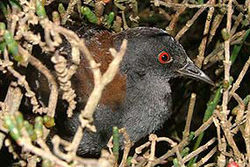Laterallus jamaicensis
| Black rail | |
|---|---|
 |
|
| Scientific classification | |
| Kingdom: | Animalia |
| Phylum: | Chordata |
| Class: | Aves |
| Order: | Gruiformes |
| Family: | Rallidae |
| Genus: | Laterallus |
| Species: | L. jamaicensis |
| Binomial name | |
|
Laterallus jamaicensis Gmelin, 1789 |
|
The black rail (Laterallus jamaicensis) is a mouse-sized member of the bird family Rallidae.
This bird has sometimes been considered conspecific with the Peruvian Junín crake (L. tuerosi) and the Galapagos crake (L. spilonotus).
It will often make its presence known with its distinctive ki-ki-krr call or an aggressive, presumably territorial, growl. This is primarily uttered during the night, when these birds are most vocal.
It is found in scattered parts of North America and the Pacific region of South America, usually in coastal salt marshes but also in some freshwater marshes. It is extinct or threatened in many locations due to habitat loss. The largest populations in North America are in Florida and California.
The black rail is rarely seen and prefers running in the cover of the dense marsh vegetation to flying.
This rail is territorial during the breeding season, and occasionally males will mate with two or more females.
The nests of this bird are placed on the ground, in dense, swampy vegetation or in patches of flooded grass. The nests are bowl-shaped and built with vegetation loosely woven.
The clutch of this bird usually consists of six to eight creamy white speckled, with reddish-brown spots, eggs. These eggs are roundish and measure around 23 by 17 millimetres (0.91 by 0.67 in). They are incubated by both parents, taking shifts of approximately one hour each, for 16 to 20 days. The precocial young then hatch. These young can, within a day of hatching, leave the nest and swim.
Black rails appear to be omnivorous, feeding primarily on small invertebrates but also on seeds of some marsh plants.
They are preyed upon by many avian (including hawks, egrets, and herons) and mammalian (including foxes and cats) predators and rely on the cover of thick marsh vegetation for protection. High tides are dangerous time for black rails as they are quite vulnerable to predation outside the marsh.
...
Wikipedia

